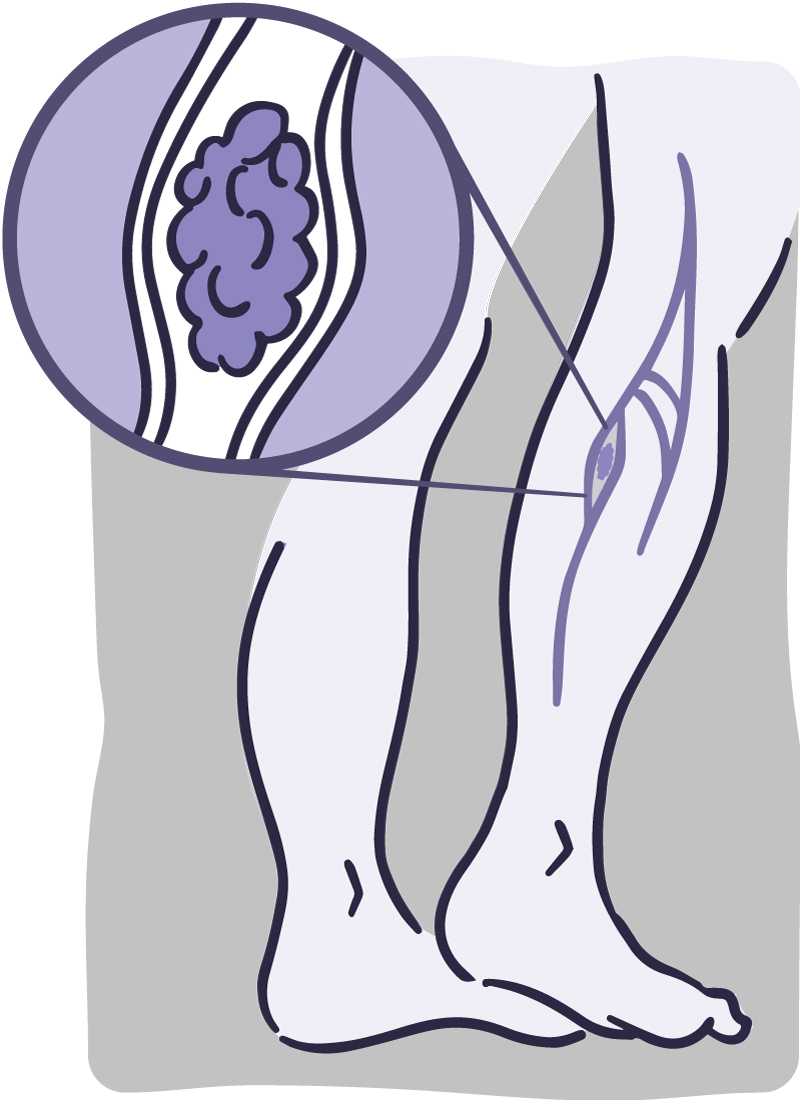How to Spot and Prevent Deep Vein Thrombosis
When the Clot Thickens

Lots of things can cause pain and swelling in your leg. But if your symptoms stem from a blood clot deep in your leg, it can be dangerous. Blood clots can happen to anyone, anytime. But some people are at increased risk. Taking steps to reduce your chances of a blood clot forming in your veins can help you avoid potentially serious problems.
Blood clots can arise anywhere in your body. They develop when blood thickens and clumps together. When a clot forms in a vein deep in the body, it’s called deep vein thrombosis. Deep vein blood clots typically occur in the lower leg or thigh.
“Deep vein thrombosis has classic symptoms—for example swelling, pain, warmth, and redness on the leg,” says Dr. Andrei Kindzelski, an NIH blood disease expert. “But about 30–40% of cases go unnoticed, since they don’t have typical symptoms.” In fact, some people don’t realize they have a deep vein clot until it causes a more serious condition.
Deep vein clots—especially those in the thigh—can break off and travel through the bloodstream. If a clot lodges in an artery in the lungs, it can block blood flow and lead to a sometimes-deadly condition called pulmonary embolism. This disorder can damage the lungs and reduce blood oxygen levels, which can harm other organs as well.
Some people are more at risk for deep vein thrombosis than others. “Usually people who develop deep vein thrombosis have some level of thrombophilia, which means their blood clots more rapidly or easily,” Kindzelski says. Getting a blood clot is usually the first sign of this condition because it’s hard to notice otherwise. In these cases, lifestyle can contribute to a blood clot forming—if you don’t move enough, for example. Your risk is higher if you’ve recently had surgery or broken a bone, if you’re ill and in bed for a long time, or if you’re traveling for a long time (such as during long car or airplane rides).
Having other diseases or conditions can also raise your chances of a blood clot. These include a stroke, paralysis (an inability to move), chronic heart disease, high blood pressure, surgical procedure, or having been recently treated for cancer. Women who take hormone therapy pills or birth control pills, are pregnant, or within the first 6 weeks after giving birth are also at higher risk. So are those who smoke or who are older than 60. But deep vein thrombosis can happen at any age.
You can take simple steps to lower your chances for a blood clot. Exercise your lower leg muscles if you’re sitting for a long time while traveling. Get out of bed and move around as soon as you’re able after having surgery or being ill. The more active you are, the better your chance of avoiding a blood clot. Take any medicines your doctor prescribes to prevent clots after some types of surgery.
A prompt diagnosis and proper treatment can help prevent the complications of blood clots. See your doctor immediately if you have any signs or symptoms of deep vein thrombosis or pulmonary embolism (see the Wise Choices box). A physical exam and other tests can help doctors determine whether you’ve got a blood clot.
There are many ways to treat deep vein thrombosis. Therapies aim to stop the blood clot from getting bigger, prevent the clot from breaking off and moving to your lungs, or reduce your chance of having another blood clot. NIH scientists continue to research new medicines and better treatment options.
If you think you may be at risk for deep vein thrombosis, talk with your doctor.
NIH Office of Communications and Public Liaison
Health and Science Publications Branch
Building 31, Room 5B52
Bethesda, MD 20892-2094
Contact Us:
nihnewsinhealth@od.nih.gov
Phone: 301-451-8224
Share Our Materials: Reprint our articles and illustrations in your own publication. Our material is not copyrighted. Please acknowledge NIH News in Health as the source and send us a copy.
For more consumer health news and information, visit health.nih.gov.
For wellness toolkits, visit www.nih.gov/wellnesstoolkits.




